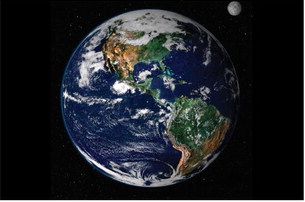NIGHT SKIES
I frequently believe that most of us are too busy with our mundane, daily lives to appreciate how beautiful our home world is. This is especially true from space.
The accompanying truecolor NASA image was taken Oct. 17, 2000, at 22,000 miles above the Earth, something you and I will never get to see in person. Well, perhaps your youngest children might get the opportunity.
As Carl Sagan said of our planet, “That’s home, that’s us. On it everyone you love, everyone you know, everyone you ever heard of, every human being who ever was, lived out their lives there. “The aggregate of our joy and suffering, thousands of confident religions, ideologies and economic doctrines, every hunter and forager, every hero and coward, every creator and destroyer of civilization, every king and peasant, every young couple in love, every mother and father, hopeful child, every teacher of morals, every corrupt politician, every supreme leader, every saint and sinner in the history of our species lived here, on a mote of dust suspended in a sunbeam.”
That certainly puts us in our place.
This is why I’ve been enamored with astronomy all my life. It’s humbling at a time when we all need to be more humble.
Astronauts often describe the “Overview Effect,” a shift in awareness when viewing the Earth from space. Seeing our planet as a fragile, blue marble emphasizes the interconnectedness of all life, the thinness of the atmosphere that protects us.
This perspective fosters a sense of unity and a deeper appreciation for the need to protect our environment. Space exploration underscores the fragility of human life; actually, all life. The hostile environment of space highlights how uniquely suited Earth is for our form of life. This realization highlights our need to steward it wisely.
It almost seems like I’m leading a sermon in church. Actually, that’s exactly correct.
On to another topic: Will we have a Great Comet this fall, specifically in mid-October? For a good part of this year, it certainly looked promising.
The well-respected amateur astronomer David Levy once wrote, “Comets are like cats; they have tails and they do precisely what they want.”
There is a lot of media hype right now about this visitor from deep space. There are a few reasons we should temper our expectations. The comet is called C/2023 A3 (how romantic; I think it should be called Shirley.)
Many comets start to break up (fragment) when they get into the inner solar system because of solar flares, heating, tidal forces. Even if it survives, it will be difficult to spot in the sky due to its solar elongation. In short, it will appear close to the sun in the evening sky making it challenging because of the sun’s glare.
The comet will be at its best from Oct. 14-18 with the comet being visible a few degrees above a clear western horizon after sunset. Any clouds near the western horizon will render it invisible. Those days will be near the full moon which will be rising in the east, the opposite side of the sky. By the time the moon has risen in the east, the comet will have set in the west.
— On Oct. 25, look southwest to see white Venus blazing to the upper right of red Antares. You’ll need to be quick to catch them before they sink below the horizon.
— We’ll have a second series of new moons Oct. 30 and 31.








Comment
Comments